Da La Pi, or potato noodles in sesame sauce, is a signature Northern Chinese dish that has a fun texture, is loaded with colorful vegetables, and gets brought together with a rich and nutty sesame-wasabi dressing. It is perfect to serve as a light main dish or salad in the warm months, or as an appetizer for a multi-course meal. {Gluten-Free Adaptable, Vegan}
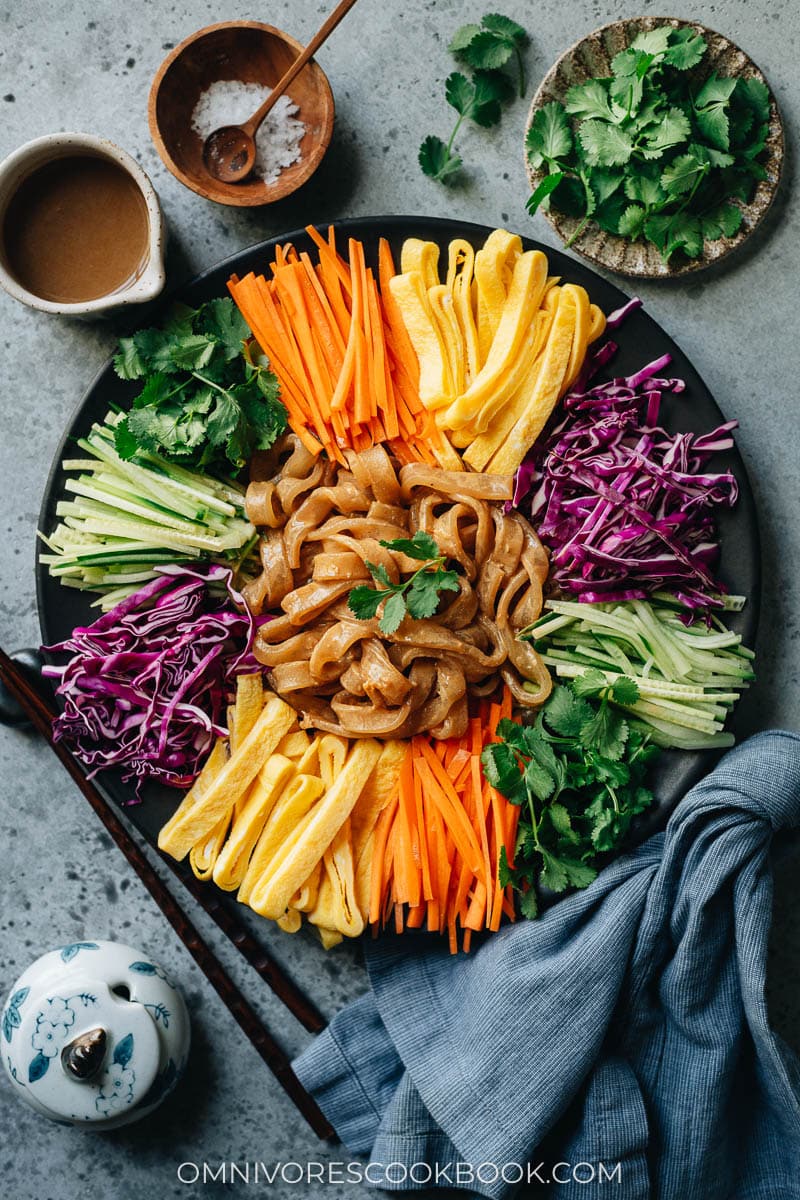
Since our last visit to Auntie Guan’s Kitchenour favorite Northern Chinese restaurant in New York City, I’ve been recreating dishes from their menu as they’re reminiscent of my fond childhood memories. So I’ve made Chao He Cai (Beijing-Style Vegetarian Moo Shu) and Pork and Sauerkraut Dumplings. And today, I can’t wait to share another favorite Northern Chinese dish with you.
Potato Noodles in Sesame Sauce, or Da La Pi (大拉皮), is a traditional Dongbei (Northeastern Chinese) dish. Its signature is the wide and thick freshly made sweet potato noodles. The noodles have a transparent look once cooked, and taste soft yet spongy. The noodles are served with colorful vegetables, ribbons of egg, and sometimes a small amount of stir fried pork on top. And everything is brought together with the rich, savory sesame sauce that has a hint of sweetness and is spiced up with wasabi (or horseradish).
It’s a dish that my family loves and one we often order in restaurants. It’s quite rare to see this one in the US, so now I’ve started making the homemade version.
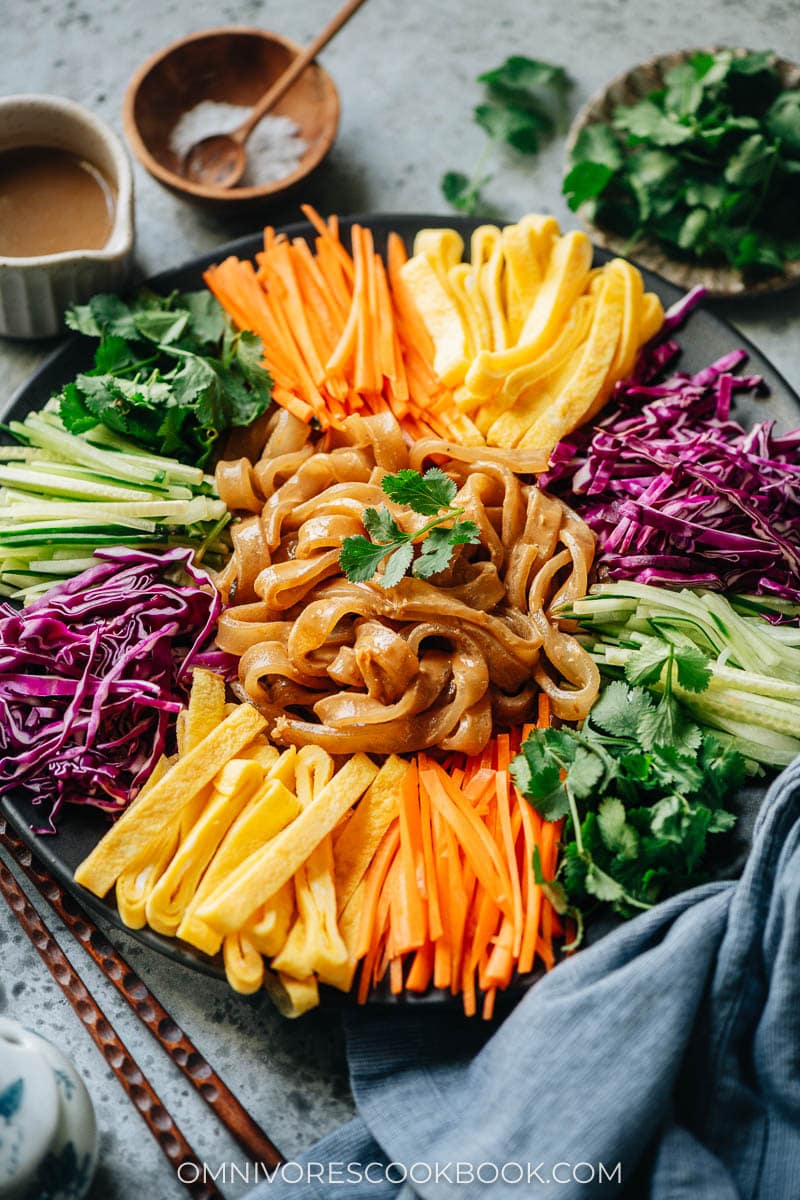
Ingredients for Da La Pi
Potato noodles
The key element of Da La Pi is the thick transparent noodles. Back in China, we use freshly made sweet potato or potato noodles. They’re often very wide, about 2” (5 cm) or so, with a soft, spongy and even gooey texture.
Here in the US, I was surprised to find fresh potato noodles at H Mart designed specifically for Da La Pi (see the picture below, it’s the package on the right). These noodles are not as wide as the ones in China, but the thick and chewy texture makes them quite authentic. You can find them in the refrigerated section at H Mart and some Chinese markets.
Alternatively, you can use dried potato starch noodles (or the wide type of sweet potato starch noodles). Their texture is a bit more chewy, and I’ve found that their ability to coat with sauce is not as nice as the fresh ones. But if that’s your only choice, go for it and your dish will still turn out great.
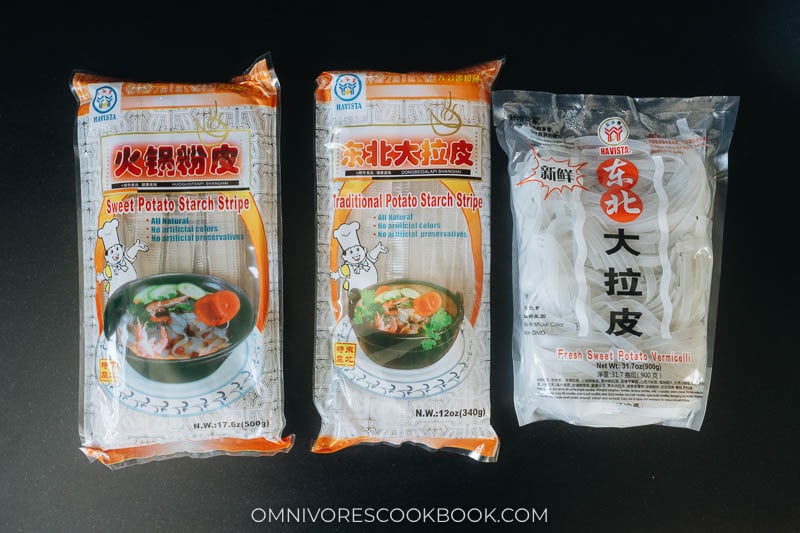
If none of these options are available, you can use rice noodles. Choose the wide type if possible for a similar texture.
Topping options
The most common topping for Da La Pi is cucumber, carrot and cilantro. Some versions use purple cabbage and ribbons of egg, which I love. That’s why I’ve included them in the recipe below. Other topping options include cherry tomatoes, sliced radishes and sliced sweet peppers.
If you prefer a more substantial dish, you can add some protein to it. Although the traditional version usually uses stir fried shredded pork, I’ve found that leftover shredded rotisserie chicken, pulled pork, deli roast beef and baked tofu all work very well.
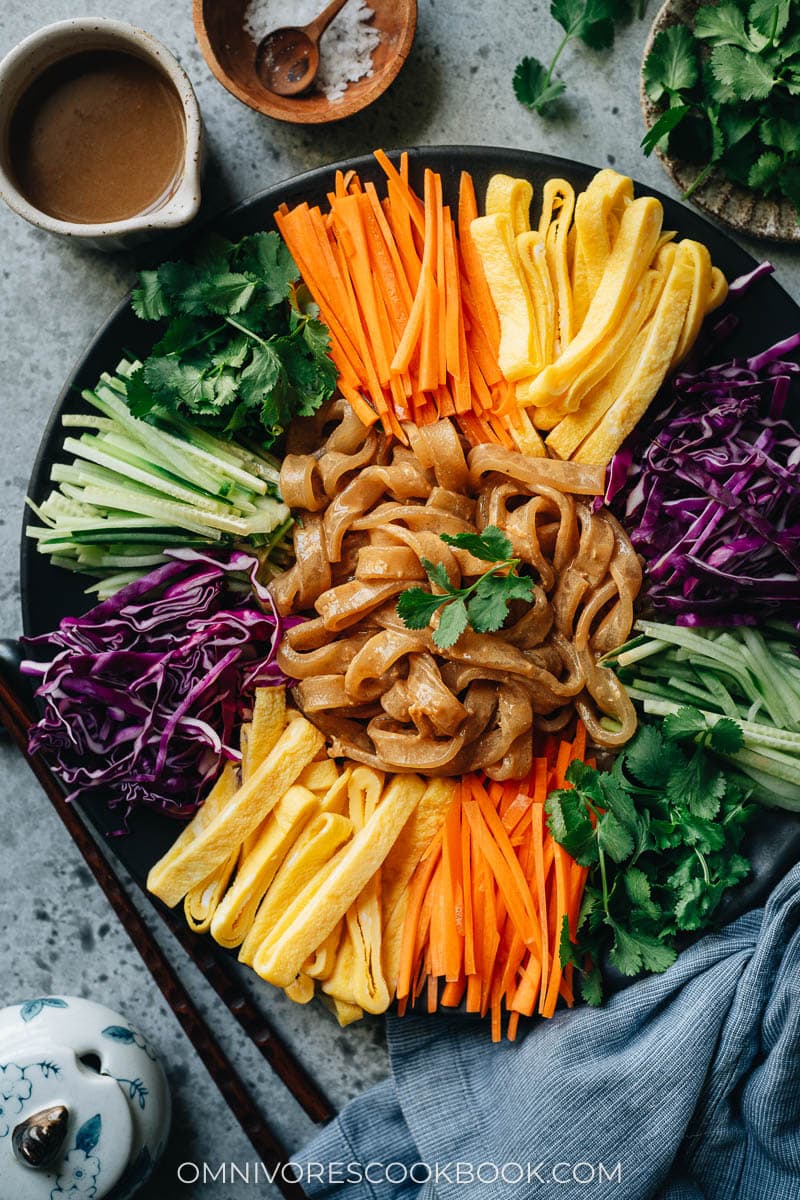
TIP: To slice the vegetables faster, use a Mandoline Slicer. If you’re in a hurry, use 2 to 3 cups of pre-cut coleslaw mix to replace the vegetables.
How to make Da La Pi
Making Da La Pi is super easy. The sauce is great for making ahead of time and using later.
- Make the egg ribbons by pouring the egg mixture into a heated pan
- Roll up the egg as soon as it’s set
- Once the egg cools off, slice it into ribbons
- Cook the potato noodles according to package directions (if using dried, you will need to pre-soak them)
- Mix the cooked potato noodles with half of the sauce
- Plate the noodles in the center of your dish, with the vegetables around the outside
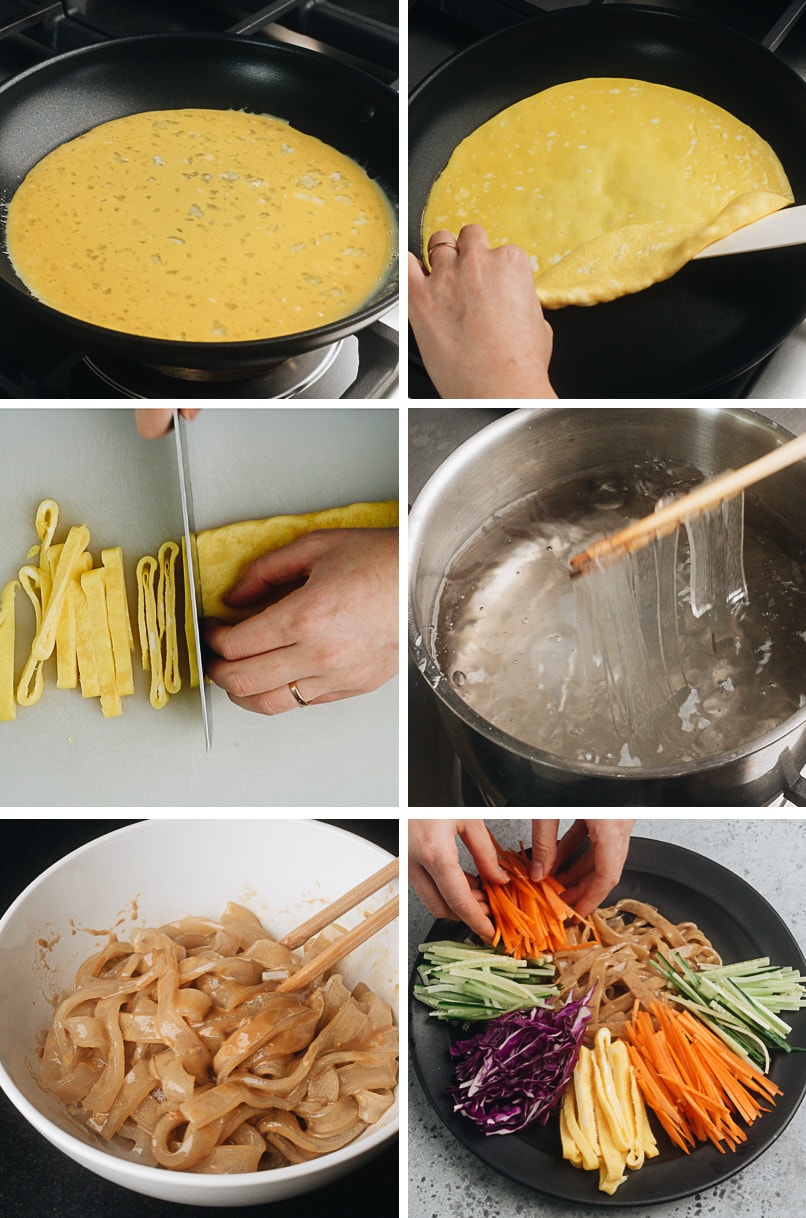
The authentic presentation of Da La Pi uses colorful vegetables to surround the noodles in the middle, creating a stunning look. When you start to eat, simply pour on the rest of the sauce and mix everything together.
Of course you don’t have to plate Da La Pi this way for a quick weekday dinner. You can dump everything into a large mixing bowl and toss everything together with the sauce.
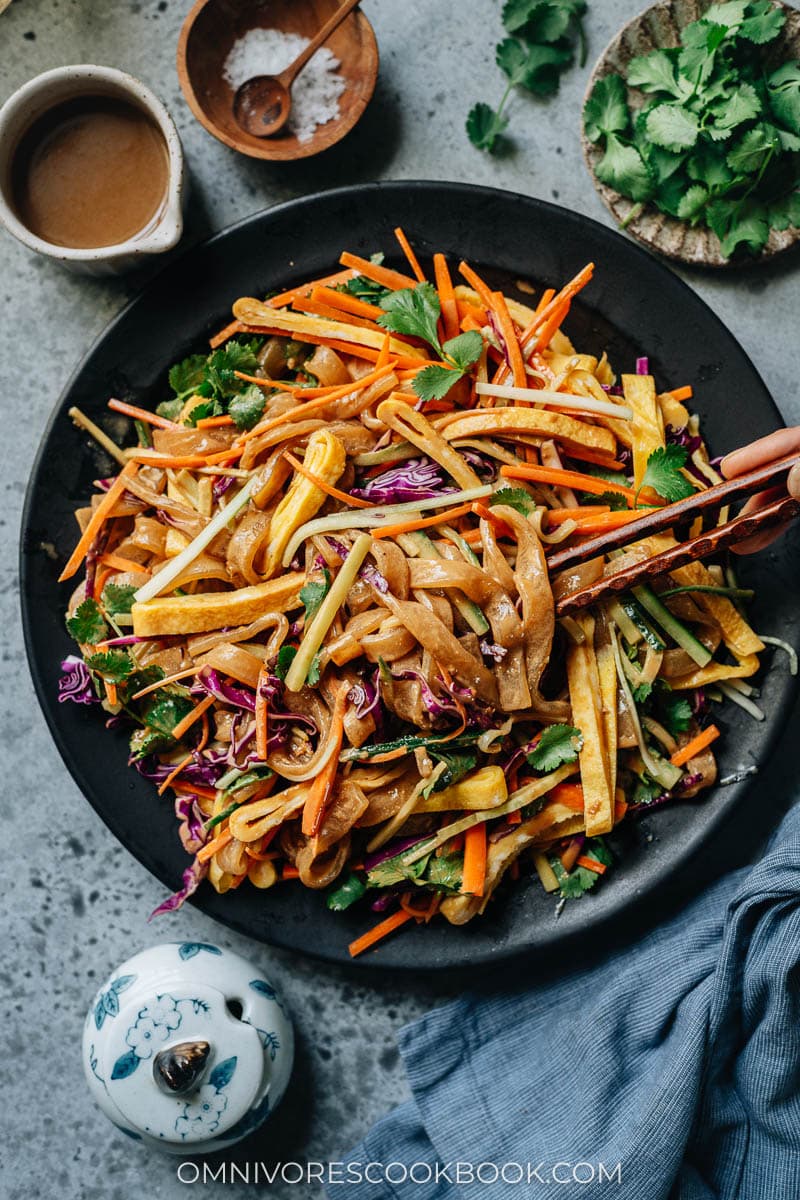
How to serve Da La Pi
We often serve Da La Pi as a cold appetizer during a multi-course meal. It’s also one of those dishes that are perfect to serve with dumplings.
However, you can totally serve it as a one-bowl meal for lunch or a light dinner. As I mentioned above, you can top it with the protein of your choice to make it more filling. And of course, you can also serve this dish as a salad course for dinner, paired with other main courses such as a meat stir fry.
NOTE: The potato noodles are not suitable for storing in the fridge. The texture will toughen up and become quite weird. If you make the dish ahead of time, you will need to store it at room temperature (for a couple of hours) to warm back up. The best way is to make the sauce and prepare the vegetables ahead of time, and cook the noodles right before you serve it.

Other delicious Northern Chinese dishes
Serve Da La Pi with these recipes to create a Northern Chinese feast!
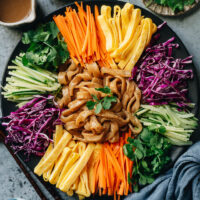
Da La Pi (Chinese, Northern Chinese Potato Noodles in Sesame Sauce)
Ingredients
Shredded eggs
- 2 eggs beaten
- 1 teaspoon cornstarch
- 2 tablespoons water
- Pinch of salt
- Pinch of sugar
- Oil spray for cooking
Noodle bowl
- 7 oz (200 g) fresh potato noodles (or 3.5 oz / 100 g dried potato noodles)
- 1 small carrot sliced to thin strips
- 1/2 English cucumber sliced to thin strips
- 1 cup purple cabbage thinly sliced
- 1/3 cup cilantro chopped
Instructions
Soak the noodles (Optional)
To make the shredded eggs
-
Crack the eggs into a medium-sized bowl and beat until even and smooth. Add the cornstarch and water into a smaller bowl, stir to mix well until the cornstarch is dissolved, and pour it into the beaten eggs. Add the salt and sugar. Stir to mix well.
-
Spray (or drizzle) a small amount of oil onto a large nonstick skillet and use paper towels to wipe the oil so the skillet is very thinly coated. Heat over medium heat for 20 seconds. Pour in the beaten egg mixture and immediately swirl the skillet so the egg spreads out into a thin, round layer. Cook until the eggs are mostly set, 1 to 2 minutes. Turn off the heat. Slowly use a spatula to loosen the egg and fold it over a few times, then transfer to a cutting board.
-
Wait until the eggs are cool enough to handle. Slice it into thin strips about 1/4 (1/2 cm) wide.
To mix the sauce
-
Add the sesame paste into a medium-sized bowl. Slowly add warm water and whisk with a spoon, until it forms a smooth paste.
-
Add the rest of the sauce ingredients. Stir to mix well. If the sauce is still too thick, almost like a dipping sauce, add 1 or 2 more tablespoons of water and mix again, until it reaches a salad dressing consistency.
To make the noodle bowl
-
Cook the soaked potato noodles according to package directions. Taste a noodle before draining, to make sure it’s fully cooked through. Once done, drain well and rinse with cold tap water to stop cooking. Drain again and transfer the noodles to a medium-sized bowl. Toss with half of the sauce, then transfer to the center of a big plate.
-
Place the cucumber, carrot, purple cabbage and sliced eggs around the noodles. Garnish with cilantro and serve with the rest of the sauce on the side.
-
Toss everything together with the rest of the sauce. Serve at room temperature as an appetizer.
Notes
- If you are using a newly bought jar of sesame paste, you’ll notice oil floating on the top. Use a chopstick to stir the mixture for at least 10 minutes, so the oil blends into the paste for a more smooth and consistent texture (it’s the same as natural peanut butter or tahini).
- Read the package instructions carefully. Some of the noodles require pre-soaking, and some can be boiled directly. However, if using the super thick sweet potato noodles, pre-soaking is usually beneficial so the noodles will cook more evenly. If the package has no instructions, soak the wide noodles in warm water for 30 minutes until soft throughout, then boil for 5 to 10 minutes until cooked through (you need to check on the noodles from time to time because each kind can require a different boiling time depending on the manufacturing method).
Video
Nutrition
Serving: 1serving, Calories: 268kcal, Carbohydrates: 33.7g, Protein: 8g, Fat: 11.7g, Saturated Fat: 2g, Cholesterol: 82mg, Sodium: 657mg, Potassium: 275mg, Fiber: 3.6g, Sugar: 5.4g, Calcium: 112mg, Iron: 2mg

